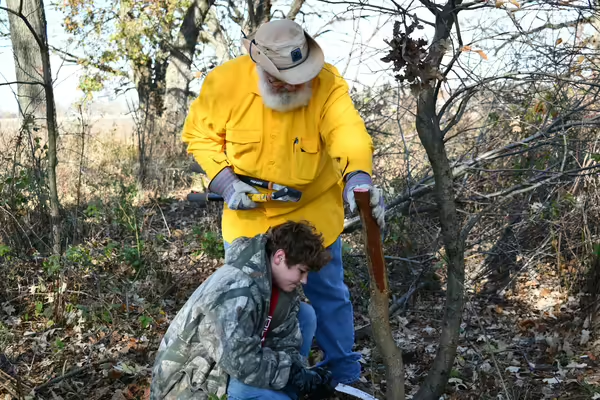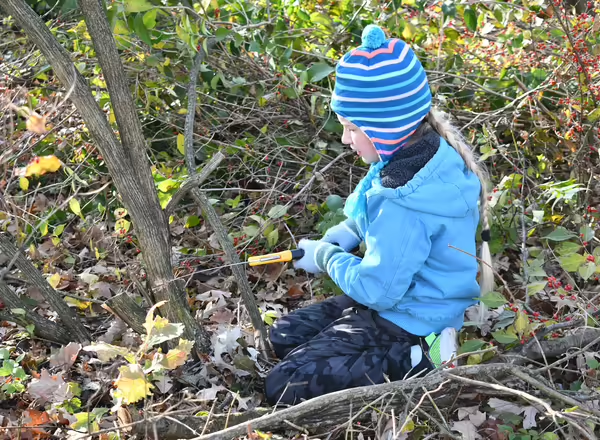
SIBLEY, Ill -- On the chilly morning of November 2, 45 dedicated volunteers gathered at Sibley Burr Oak Grove for a community-led restoration event to protect one of the region’s most precious natural landmarks. Guided by organizations such as the East Central Illinois Master Naturalists, The Nature Conservancy, the Illinois Nature Preserves Commission, and the Illinois Department of Natural Resources, participants worked together to remove invasive plant species, clear underbrush, and foster the return of native ecosystems.
Master Naturalist volunteer and Ford County resident Terri Davis spearheaded and organized the cleanup effort. Davis grew up near the grove and had many fond memories of it from her childhood. “It was a place where people picnicked, and families came to hike through the woods,” Davis shared. “Right now, it's so full of invasives that people can’t take advantage of that.”


The Sibley Burr Oak Grove is a unique natural treasure which contains three ecosystems: oak savannahs, wetlands, and restored prairies. It is home to a collection of centuries-old Burr Oak trees, some dating back more than 400 years, and several diverse species, including the American woodcock, which a few volunteers were lucky enough to see. However, it also holds a unique place in the cultural history of Ford County, as county historian Derrick Babbs explained to the crowd at the beginning of the cleanup. The grove was the location of the first settlement that would eventually become Sibley after farmer Michael Sullivant bought 32,000 acres of land. Yet, over recent years, invasive plants have begun to threaten its ecological integrity, reducing the area’s biodiversity and accessibility. Local residents, Master Naturalists, Boy Scouts, and others passionate about land stewardship came together for a day of hard work and dedication to reclaim the grove from encroaching species like bush honeysuckle and autumn olive. After a brief introductory session, volunteers split into groups and cleared invasive growth, starting at the grove’s northern edge and working toward the wetland area.
Babbs shared what it meant to him to see so many people at the event, “I think it’s great that people have come together to come here today. [The cleanup] couldn’t be done with just three or four people. This is such a huge undertaking; you almost have to have all these people out here.”


The work done during the event was more than just environmental upkeep. Davis views it as an essential step toward reclaiming the grove as a community space for recreation and relaxation—a place where families can once again picnic, hike, and enjoy the beauty of nature. She reflected on her vision for the grove’s future: "The big goal is restoring it so people can enjoy it.”
After the work was done, volunteers were invited to gather for refreshments provided by other volunteers. Many had staffed the check-in table, distributed tools, and offered treats and warm drinks to keep spirits high during the chilly day. The event concluded with a talk from John Griesbaum, Natural Areas Preservation Specialist with the Illinois Nature Preserves Commission, who spoke about the need for future events to maintain the grove’s health and biodiversity.
Davis emphasized the importance of building a community around the project. “It’s so encouraging to see the interest in stewarding the grove. I’m encouraged by the local volunteers and others who came from Pontiac and Champaign and out of the area to help steward the grove.” Reflecting on her motivation, she added, “It hurt my heart to see the grove deteriorating like it did. I’ve known the grove my whole life; I grew up four miles away from the grove. Before I get too old and frail to help lead the local community groups, I want to get the community involved. I want to get community groups and community involvement to develop a corps of people that will stay involved and nurture future stewards of the grove as well.”

Looking ahead, the organizers plan to host at least three cleanup days each year, with the next event tentatively scheduled for late February. Among the Boy Scouts who attended, one scout pledged that their troop would be involved in future efforts. This promising commitment reflects the event’s positive impact and the lasting bonds formed among participants.
With efforts like these, the hope is that Sibley Burr Oak Grove will thrive as a sanctuary of biodiversity and natural beauty for generations to come. Organizers call for more community groups to join future cleanups to protect and restore this cherished local landmark.
Thumbnail Caption: A young volunteer and an adult volunteer work together to cut down the stump of an invasive at the Sibley Burr Oak Grove cleanup day.
The Illinois Extension Master Naturalist Program is a volunteer training program offered by University of Illinois Extension. East Central Illinois Master Naturalist is our local chapter of the program, including volunteers from Champaign, Ford, Iroquois, and Vermilion counties. Since establishing the East-Central Illinois Master Naturalist program in 2005, almost 400 residents have taken our Master Naturalist training. Volunteer efforts have provided over 98,000 hours of service valued at more than $2,000,000 to East-Central Illinois. With many hands, we make a big difference.
If you would like to become a master naturalist or learn more about the East Central Illinois Master Naturalists, visit go.illinois.edu/ECIMN or contact our office at 217-333-7672.
University of Illinois Extension develops educational programs, extends knowledge, and builds partnerships to support people, communities, and their environments as part of the state's land-grant institution. Extension serves as the leading public outreach effort for University of Illinois Urbana-Champaign and the College of Agricultural, Consumer and Environmental Sciences in all 102 Illinois counties through a network of 27 multi-county units and over 700 staff statewide. Extension’s mission is responsive to eight strategic priorities — community, economy, environment, food and agriculture, health, partnerships, technology and discovery, and workforce excellence — that are served through six program areas — 4-H youth development, agriculture and agribusiness, community and economic development, family and consumer science, integrated health disparities, and natural resources, environment, and energy.